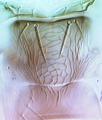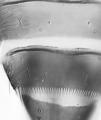Ceratothripoides claratris
Recognition data
Distinguishing features
Both sexes fully winged. Body brown, legs yellow with extensive brown shadings particularly on femora, antennal segment III yellow, IV–V variably yellow and brown, forewings pale but weakly shaded. Head slightly longer than wide, 3 pairs of ocellar setae present, III almost twice as long as lateral margin of ocellar triangle, arising close to anterolateral margin. Antennae 8-segmented, segment I with a pair of small setae dorsally close to the apical margin. Pronotum with 2 pairs of posteroangular setae. Metanotum irregularly reticulate, posterior reticles smallest, median setae at anterior margin and more than two-thirds as long as metanotum, paired campaniform sensilla absent. Forewing first vein with only 2 setae on distal half, second vein with 14–16 setae. Abdominal tergites with sculpture lines scarcely extending mesad to campaniform sensilla, without ctenidia; tergite VIII with long regular marginal comb. Sternites without discal setae, marginal setae as long as sternites; sternite VII setae S1 and S2 arising well in front of margin.
Male smaller, sternites III–VII each with about 12 small pore plates in two irregular transverse rows.
Related and similar species
The genus Ceratothripoides currently includes five species from Africa and the Oriental region. However, the distinction between the Oriental species C. claratris and the African species C. cameroni remains equivocal (Mound & Nickle, 2009). Species in Ceratothripoides have a pair of small setae dorsally near the apex of the first antennal segment, but otherwise are similar in appearance to species of Ewartithrips and Tenothrips.
Taxonomic data
Current valid name
Ceratothripoides claratris (Shumsher)
Original name and synonyms
- Taeniothrips claratris Shumsher, 1946: 178
- Mycterothrips moultoni Seshadri & Ananthakrishnan, 1954: 213
- Ceratothrips reticulatus Reyes, 1994: 183
Family placement
Thripidae, Thripinae
Common name
Oriental tomato thrips
Biological data
Life history
Breeding in flowers, on young fruits, and on leaves
Host plants
Associated with tomato plants, on which it is reported to cause considerable damage.
Tospoviruses vectored
Capsicum chlorosis virus (Premachandra et al., 2005)
Crop damage
This species causes considerable damage to tomato plants and fruits in Thailand (Premachandra et al., 2004).
Distribution data
Crop damage
This species causes considerable damage to tomato plants and fruits in Thailand (Premachandra et al., 2004).
Area of origin
Oriental region
Distribution
India to Thailand, but a potentially invasive species in horticultural trade.







